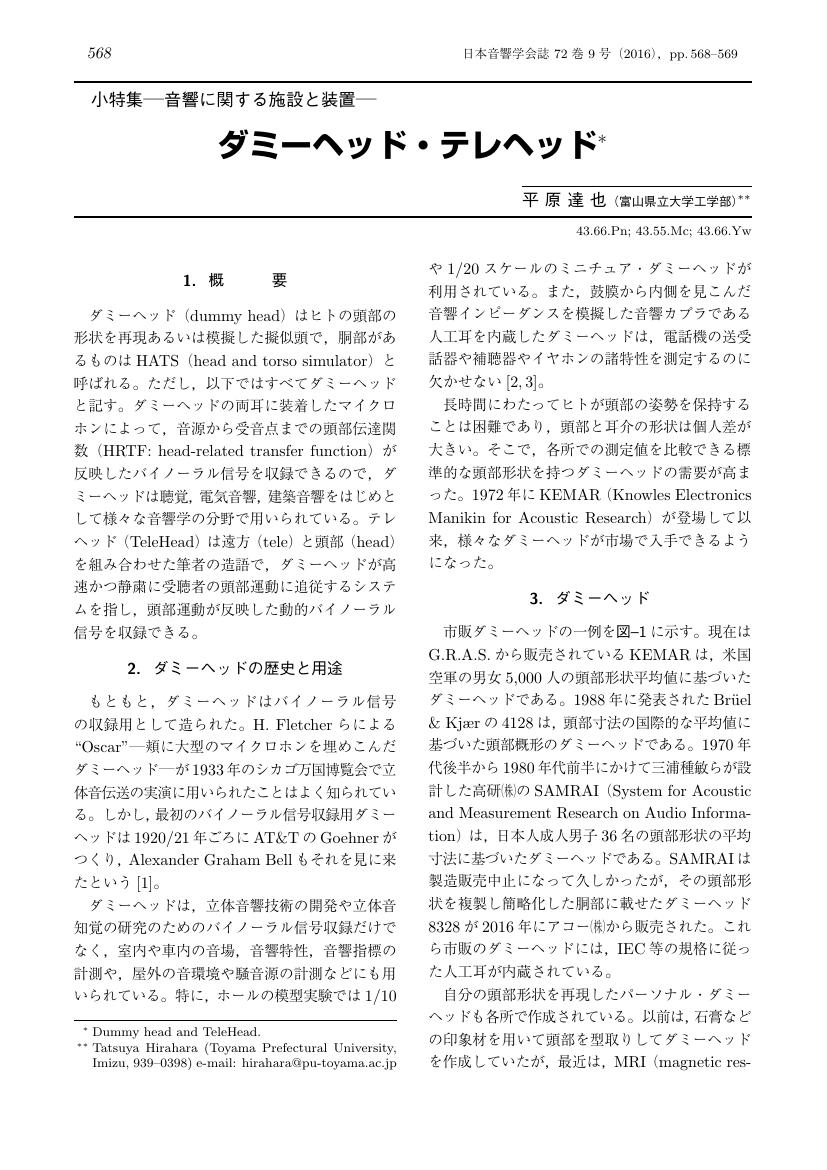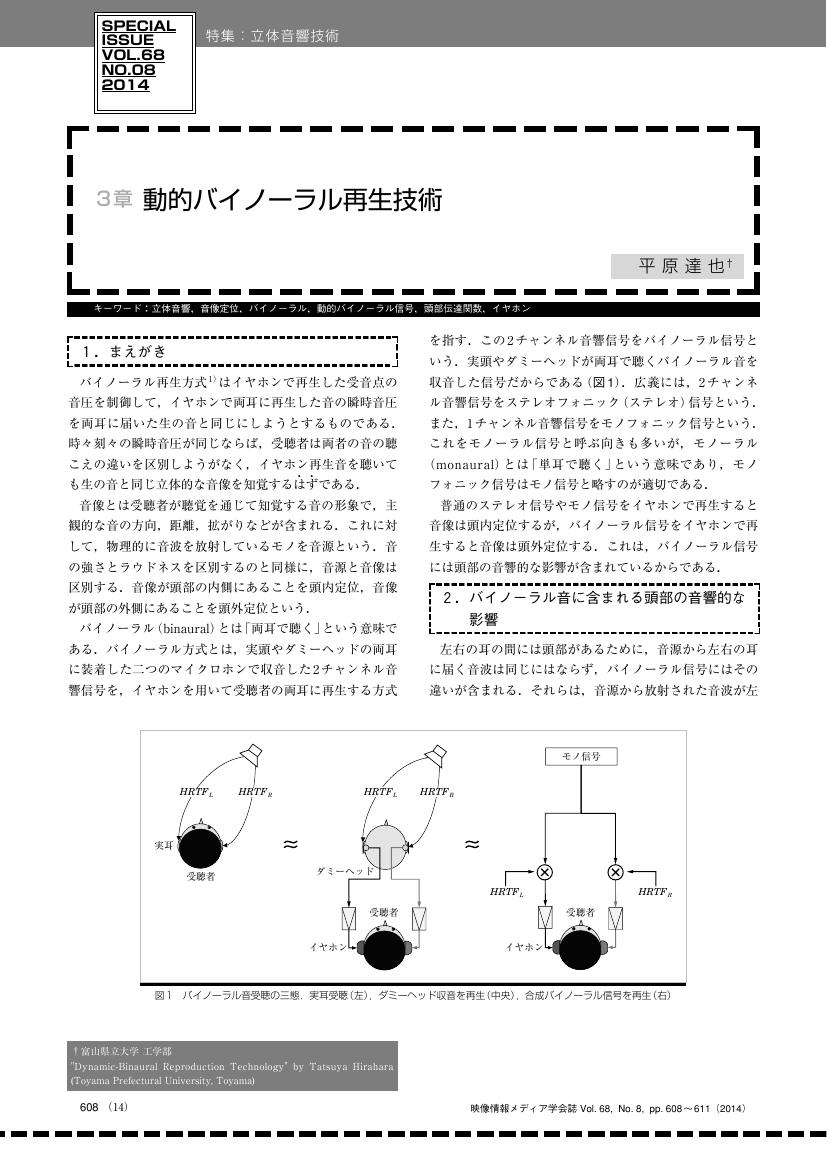55 0 0 0 OA 頭部伝達関数の計測とバイノーラル再生にかかわる諸問題
- 著者
- 平原 達也 大谷 真 戸嶋 巌樹
- 出版者
- 一般社団法人 電子情報通信学会
- 雑誌
- 電子情報通信学会 基礎・境界ソサイエティ Fundamentals Review (ISSN:18820875)
- 巻号頁・発行日
- vol.2, no.4, pp.4_68-4_85, 2009-04-01 (Released:2011-05-01)
- 参考文献数
- 109
- 被引用文献数
- 5 5
音源信号に頭部伝達関数が畳みこまれたバイノーラル信号によって立体音像空間を再現する場合に,頭部伝達関数やバイノーラル信号再生系の音響的な厳密さが重要視されている.しかし,受聴者の頭部運動に追従する動的バイノーラル信号を用いると,頭部伝達関数やバイノーラル信号再生系に要求される音響的厳密性を緩和できる.本解説では,複数箇所で多数回計測した実頭とダミーヘッドの頭部伝達関数を精査し,頭部伝達関数の音響計測の問題点,頭部形状の変形に伴う頭部伝達関数の変化,および,頭部伝達関数の比較尺度について論じる.また,様々なバイノーラル信号を用いた一連の音像定位実験の結果に基づいて,静的バイノーラル信号と動的バイノーラル信号が再現する立体音像空間の差異についても論じる.これらを通じて,頭部伝達関数の計測とバイノーラル信号の再生にかかわる諸問題について論考する.
37 0 0 0 九官鳥の真似声構音モデル : ヘリウム音声による解析
- 著者
- 平原 達也 伊福部 達 吉本 千禎
- 出版者
- 一般社団法人 日本音響学会
- 雑誌
- 日本音響学会誌 (ISSN:03694232)
- 巻号頁・発行日
- vol.38, no.6, pp.321-329, 1982
- 被引用文献数
- 4
In order to analyze the articulation mechanism of a talking bird "Mynah, " mimic voices obtained in He- O_2 atmosphere are compared with those in the normal air based on the frequency analysis by linear prediction. A mixture of 80%-He and 20%-0_2 at one atm is used in the experiment of helium voices, and 36 mimic voices consisted of words are recorded by a taperecorder in both cases. Comparing vowel parts of normal voices with those of helium voices, it is found that the spectrum pattern of mimic voices has two types, I and II, about the structure of spectral envelope peak components. Type I shows the frequency shift in helium atmosphere and type II shows no frequency shift. Spectral envelope peak components of type I appear around 0. 8-1. 2kHz, 1. 8-2. 4kHz and 3. 8-4. 4kHz, and their frequencies do not change with vowels. On the other hand, the component of type II appears in the range from 1. 5 to 3kHz and its frequency changes with vowels. It is ascertained that (1) only the spectral envelope peak components of type I show almost the same frequency shift as those estimated by the formula describing theoretical transformation of peak frequencies, (2) spectral envelope peak frequencies of type I coincide with resonance frequencies obtained by twin-tube model of which parameters correspond to the vocal tract of Mynah, (3) the number of observed spectral envelope peaks are beyond that of the resonances calculated by twin-tube model, and (4) the observed spectral envelope coincides with one which is obtained by adding a component of type II to the spectral envelope estimated from the source-system model using spectral envelope peaks of type I as poles. From above results and analyses, it is confirmed that type I has multi peak components which are formed by resonances of the vocal tract, and type II has a single peak component which may not be formed by the resonance. Furthermore, it is assumed that Mynah's syrinx may produce two components as sound sources. The first one has a wide range spectrum composed of pitch and its harmonics, which is similar to the sound source by human's vocal cord. The second one has a higher frequency component corresponding to type II. This hypothesis may be also supported by the anatomical structure of the syrinx. From above considerations, it is concluded that Mynah may produce the vowel part of mimic voices by controlling the frequency of the second sound source in addition to use almost fixed resonance components obtained by its vocal tract.
14 0 0 0 OA ダミーヘッド・テレヘッド
- 著者
- 平原 達也
- 出版者
- 一般社団法人 日本音響学会
- 雑誌
- 日本音響学会誌 (ISSN:03694232)
- 巻号頁・発行日
- vol.72, no.9, pp.568-569, 2016-09-01 (Released:2017-07-01)
- 参考文献数
- 6
13 0 0 0 OA 九官鳥の真似声構音モデル : ヘリウム音声による解析
- 著者
- 平原 達也 伊福部 達 吉本 千禎
- 出版者
- 一般社団法人 日本音響学会
- 雑誌
- 日本音響学会誌 (ISSN:03694232)
- 巻号頁・発行日
- vol.38, no.6, pp.321-329, 1982-06-01 (Released:2017-06-02)
- 被引用文献数
- 1
In order to analyze the articulation mechanism of a talking bird "Mynah, " mimic voices obtained in He- O_2 atmosphere are compared with those in the normal air based on the frequency analysis by linear prediction. A mixture of 80%-He and 20%-0_2 at one atm is used in the experiment of helium voices, and 36 mimic voices consisted of words are recorded by a taperecorder in both cases. Comparing vowel parts of normal voices with those of helium voices, it is found that the spectrum pattern of mimic voices has two types, I and II, about the structure of spectral envelope peak components. Type I shows the frequency shift in helium atmosphere and type II shows no frequency shift. Spectral envelope peak components of type I appear around 0. 8-1. 2kHz, 1. 8-2. 4kHz and 3. 8-4. 4kHz, and their frequencies do not change with vowels. On the other hand, the component of type II appears in the range from 1. 5 to 3kHz and its frequency changes with vowels. It is ascertained that (1) only the spectral envelope peak components of type I show almost the same frequency shift as those estimated by the formula describing theoretical transformation of peak frequencies, (2) spectral envelope peak frequencies of type I coincide with resonance frequencies obtained by twin-tube model of which parameters correspond to the vocal tract of Mynah, (3) the number of observed spectral envelope peaks are beyond that of the resonances calculated by twin-tube model, and (4) the observed spectral envelope coincides with one which is obtained by adding a component of type II to the spectral envelope estimated from the source-system model using spectral envelope peaks of type I as poles. From above results and analyses, it is confirmed that type I has multi peak components which are formed by resonances of the vocal tract, and type II has a single peak component which may not be formed by the resonance. Furthermore, it is assumed that Mynah's syrinx may produce two components as sound sources. The first one has a wide range spectrum composed of pitch and its harmonics, which is similar to the sound source by human's vocal cord. The second one has a higher frequency component corresponding to type II. This hypothesis may be also supported by the anatomical structure of the syrinx. From above considerations, it is concluded that Mynah may produce the vowel part of mimic voices by controlling the frequency of the second sound source in addition to use almost fixed resonance components obtained by its vocal tract.
11 0 0 0 OA 音を聴く聴覚の仕組み(<小特集>誌上ビギナーズセミナー)
- 著者
- 平原 達也
- 出版者
- 一般社団法人 日本音響学会
- 雑誌
- 日本音響学会誌 (ISSN:03694232)
- 巻号頁・発行日
- vol.66, no.9, pp.458-465, 2010-09-01 (Released:2017-06-02)
- 参考文献数
- 19
9 0 0 0 OA 座談会 : 音声研究を語る : (小特集:<音声研究の新たな方向を探る>)
- 著者
- 平原 達也
- 出版者
- 一般社団法人日本音響学会
- 雑誌
- 日本音響学会誌 (ISSN:03694232)
- 巻号頁・発行日
- vol.65, no.2, pp.81-86, 2009-02-01
- 被引用文献数
- 2
5 0 0 0 OA 人間の適応能力を考慮した頭部伝達関数の適用限界に関する研究
- 著者
- 平原 達也
- 出版者
- 一般社団法人 日本音響学会
- 雑誌
- 日本音響学会誌 (ISSN:03694232)
- 巻号頁・発行日
- vol.71, no.2, pp.80-88, 2015-02-01 (Released:2017-06-02)
- 著者
- 平原 達也
- 出版者
- 一般社団法人日本音響学会
- 雑誌
- 日本音響学会誌 (ISSN:03694232)
- 巻号頁・発行日
- vol.55, no.5, pp.370-376, 1999-05-01
- 被引用文献数
- 10
5 0 0 0 聴覚実験に用いられるヘッドホンの物理特性
- 著者
- 平原 達也
- 出版者
- 一般社団法人日本音響学会
- 雑誌
- 日本音響学会誌 (ISSN:03694232)
- 巻号頁・発行日
- vol.53, no.10, pp.798-806, 1997-10-01
- 被引用文献数
- 23
聴覚実験に用いられるヘッドホンの幾かの物理特性を明らかにすることを目的として, 5種類のヘッドホンTDH 39, DT 48, HD 250 Linear II, HDA 200, SR-A Pro.のカップラレスポンス, 実耳レスポンス, 高調波歪特性, インパルス応答特性, 位相・群遅延特性, 外部幅射特性, 音響遮蔽特性, 音響クロストーク特性を測定し, 比較した結果について述べる。
5 0 0 0 聴覚実験用ヘッドホン再考
- 著者
- 平原 達也
- 出版者
- 一般社団法人電子情報通信学会
- 雑誌
- 電子情報通信学会技術研究報告. EA, 応用音響
- 巻号頁・発行日
- vol.95, no.207, pp.17-24, 1995-08-21
- 被引用文献数
- 2
聴覚実験に用いる最適なヘッドホンを特定するために、5種類のヘッドホン(TDH39, DT48, HD250 Linear II, HDA200, SR-Λ Pro.)の周波数特性、位相特性、高調波歪み特性、クロストーク特性等を物理的に測定した。その結果、HDA200とSR-ΛPro.が実耳装着時でも比較的平坦な周波数特性を持ちカップラ応答との差が少ないこと、位相特性や歪特性はどのヘッドホンでも問題ないこと、SR-ΛPro.の音響的なクロストーク特性は他のものより劣ることが分かった。また、ヘッドホンの実耳装着時の周波数特性に差異があると、F1だけを変化させた合成母音系列の音韻性判断において、周波数特性の差に応じてF1境界周波数がずれて推定されるが、ヘッドホンの周波数特性を逆フィルタで補正すればそのずれを解消できることが分かった。
4 0 0 0 OA 3.動的バイノーラル再生技術
- 著者
- 平原 達也
- 出版者
- 一般社団法人 映像情報メディア学会
- 雑誌
- 映像情報メディア学会誌 (ISSN:13426907)
- 巻号頁・発行日
- vol.68, no.8, pp.608-611, 2014 (Released:2016-08-27)
- 参考文献数
- 15
- 被引用文献数
- 1
3 0 0 0 OA イヤホンの音響特性とIEC60711カプラの問題点
- 著者
- 平原 達也 青山 裕樹 大谷 真
- 出版者
- 一般社団法人 日本音響学会
- 雑誌
- 日本音響学会誌 (ISSN:03694232)
- 巻号頁・発行日
- vol.66, no.2, pp.45-55, 2010-02-01 (Released:2017-06-02)
- 参考文献数
- 17
- 被引用文献数
- 1
様々なイヤホンの音響特性とIEC60711カプラの問題点を明らかにすることを目的として,5種類のイントラコンカ型イヤホンと3種類の挿入型イヤホンと2種類のヘッドホンのIEC60711カプラレスポンス,実耳レスポンス,位相特性,遮音特性,音響クロストーク特性,高調波歪特性を測定し比較した。その結果,イヤホン及びヘッドホンの実耳レスポンスは6〜10kHzでカプラレスポンスより6dB以上低いことが分かった。また,挿入型イヤホンの実耳レスポンスは,音響漏洩の影響により,03kHz以下でカプラレスポンスより6dB以上低いことも分かった。更に,イヤホンの位相特性と群遅延特性には特異な点はないこと,遮音量は最大でも20dB程度であること,音響クロストーク量は10kHz以下で-40dB以下であること,2〜5次の高調波歪量は-40dB以下であることが分かった。このように,イヤホンの諸特性には特段の問題は認められないが,イヤホンを聴覚実験に用いる場合は,実耳レスポンスとIEC60711カプラレスポンスとは必ずしも一致しないことを念頭において,その諸特性を適切な方法で把握しておくことが重要である。
- 著者
- 戸嶋 巌樹 青木 茂明 平原 達也
- 出版者
- 一般社団法人日本音響学会
- 雑誌
- 日本音響学会誌 (ISSN:03694232)
- 巻号頁・発行日
- vol.62, no.3, pp.244-254, 2006-03-01
- 被引用文献数
- 15
頭部形状を再現したダミーヘッドを静粛かつ滑らかに頭部運動に追従動作する音響テレプレゼンスロボット,テレヘッド弐号機を構築した。ダミーヘッドと実頭との形状の差は最大5.7%で,頭部伝達関数(HRTF)の振幅スペクトル差は4.6dBであった。テレヘッドは頭部運動に120msの遅れで安定して追従した。頭部運動追従時のライン混入雑音レベルは1〜4kHzの帯域で24dB SPL以下となった。音像定位実験の結果,使用者の頭部運動を再現すれば,他人のダミーヘッドを用いても,水平面音像定位精度が向上することを確認した。しかし,正中面音像定位においては,頭部運動を再現する効果は必ずしも認められなかった。
2 0 0 0 OA 両耳インパルス応答の測定
- 著者
- 平原 達也
- 出版者
- 一般社団法人 日本音響学会
- 雑誌
- 日本音響学会誌 (ISSN:03694232)
- 巻号頁・発行日
- vol.76, no.3, pp.172-179, 2020-03-01 (Released:2020-09-01)
- 参考文献数
- 21
2 0 0 0 絶対不快音の不快感の原因となるスペクトル的特徴
- 著者
- 澤田 優貴 平原 達也
- 出版者
- 一般社団法人電子情報通信学会
- 雑誌
- 電子情報通信学会技術研究報告. EA, 応用音響 (ISSN:09135685)
- 巻号頁・発行日
- vol.109, no.240, pp.25-29, 2009-10-15
本報告では誰もが不快に感じる絶対不快音を構成している要因を明らかにするために、16種類の不快音の音響分析と聴取実験を通じて不快感の原因となるスペクトル的特徴を明らかにする。その結果、音圧の高い音は不快度が高いこと、不快度の高い音は、5〜7kHzに強いスペクトル成分を持つこと、その強いスペクトル成分は、周波数的にも時間的にも不規則に出現していることがわかった。また、絶対不快音の強いスペクトル成分を逆フィルタで減衰させると、不快度は低くなることもわかった。
- 著者
- 松永 悟行 大谷 大和 平原 達也
- 出版者
- The Institute of Electronics, Information and Communication Engineers
- 雑誌
- 電子情報通信学会論文誌 D (ISSN:18804535)
- 巻号頁・発行日
- vol.J102-D, no.10, pp.721-729, 2019-10-01
Deep Neural Network(DNN)を用いた音声合成の基本的な構成は,文章を構成する情報を数値で表現した言語特徴量を入力して音声を合成するための特徴量を出力するものである.これらの入出力特徴量は,DNNに適するように学習データを用いて正規化や標準化することが多い.しかし,自由文章から音声を合成する場合には,この正規化の範囲や標準化の分布から外れる値が言語特徴量に含まれる可能性がある.そして,この外れ値はDNNの外挿能力が十分でないために適切に補間されないまま伝搬して出力特徴量に誤差を生じさせる.本論文では,言語特徴量の外れ値の問題を解決するために,一発話内の閉じた条件における正規化手法を提案し,日本語の音声合成で重要な要素の一つである基本周波数について,予測誤差と合成音声の聴取による評価を行った.その結果,提案した正規化手法では,従来の正規化手法で発生していた外れ値は発生しないこと,正規化した値が基本周波数に適したものになったことにより少量の学習データでも予測誤差は従来よりも小さくなり,安定した予測が可能になることがわかった.
- 著者
- 清水 奨太 大谷 真 平原 達也
- 出版者
- 一般社団法人電子情報通信学会
- 雑誌
- 電子情報通信学会技術研究報告. SP, 音声 (ISSN:09135685)
- 巻号頁・発行日
- vol.107, no.165, pp.85-90, 2007-07-19
非可聴つぶやき声(Non-Audible Murmur : NAM)の音響的特徴とソフトシリコーン型NAMマイクロフォンの特性を明らかにした。NAMは「微弱な呼気による乱流雑音の声道共鳴音の肉導音」であり,特別に設計されたNAMマイクロフォンを体表に装着させることで検出できる。NAMマイクロフォンはほぼ個体差が無く, NAMマイクロフォンの周波数特性は約-17dB/oct.で高域減衰していた。NAMマイクロフォンの感度は-36dB(1V/1 Pa=0dB@1kHz)であった。NAMマイクロフォンを用いて収録された男性話者26名・女性話者17名(約630分)のNAM信号の音響分析を行なった。このNAM信号のSNRは約16dBであり,帯域は約3kHzであった。NAM信号の長時間スペクトルは500〜800Hzにピークがあり,約-17dB/oct.で高域減衰していた。このNAM信号の長時間スペクトルからNAMマイクロフォン特性を補正して求めたNAM本来の長時間スペクトルは、200Hz〜300Hzにピークがあり、約-23dB/oct.で高域減衰していた。この結果は、声帯共鳴音が生体軟組織を伝搬する際の減衰特性の数値シミュレーションの結果とほぼ一致する。
1 0 0 0 OA 耳と音響実験機器のエージング
- 著者
- 平原 達也
- 雑誌
- 研究報告音楽情報科学(MUS) (ISSN:21888752)
- 巻号頁・発行日
- vol.2018-MUS-121, no.29, pp.1-6, 2018-11-14
音響実験機器の諸特性は,使用期間が長くなると変化する.かつて,新しい機器はエージング (慣らし運転) を行い,使いこんだ機器も電源投入時にはエージング (暖機運転) を行うことが普通であった.ところが,今日では,電源投入とともに受聴実験や音響測定を始めることが少なくないように思う.ディジタル音響機器のエージングはもはや不要なのだろうか? 耳の諸特性も,使用期間が長くなると変化する.高齢者の耳は,そのフロントエンドの感度が低下するだけでなく,バックエンドのさまざまな機能が低下する.これは高齢者だけの問題なのだろうか? 本稿では,このような音響実験機器と耳のエージングについていくつかの事例を紹介する.





